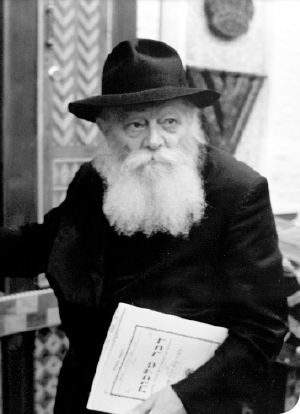From Chapter Six of Rabbi Shloma Majeski’s Likkutei Mekoros (Underlined text is the compiler’s emphasis(
Translated by Boruch Merkur
 25. In general, the laws of Tzaraas can be connected with the advent of Moshiach Tzidkeinu, based on the following passage in Gemara:
25. In general, the laws of Tzaraas can be connected with the advent of Moshiach Tzidkeinu, based on the following passage in Gemara:
“What are the signs of Moshiach [i.e., how is he identified]? He sits among the poor who suffer illnesses.” Rashi interprets: “[Moshiach sits among] menuga’im, those who are afflicted with ‘leprosy.’ And he too is a ‘leper,’ as it is written, ‘And he was stricken with illnesses because of our transgressions,’ and it is written, ‘Indeed, he boar our illnesses.’”
The Gemara goes on to describe Moshiach’s role in ensuring that the redemption comes quickly: “They [i.e., the other ‘lepers’] remove all their bandages at once and reapply them all, but he removes one and then reapplies it, saying, ‘lest I am needed [I must be ready] so that I won’t delay [the redemption].’” That is to say, “All of them follow this approach: One who has four or five affected areas on his skin, removes all his bandages in one instance, cleanses the wounds, and reapplies the bandages. But Moshiach, removes only a single bandage, cleanses the wound, and dresses the wound afresh. Thereafter, he unties another single bandage and follows the same procedure. He doesn’t untie two bandages at once in case he is needed that very moment to go out and redeem the Jewish people. He doesn’t want to delay the redemption even the short amount of time it takes to dress two wounds”!
The above sheds light on the extent to which alacrity, speed, is pertinent to the redemption, as it was in the exodus from Mitzrayim: “The Alm-ghty did not delay even the blink of an eye,” a duration of time that is even shorter than “rega k’meimra,” the time it takes to utter two syllables.
Also derived from the above is that sensitivity to a Jew’s physical wellbeing is vital to the final redemption (as in today’s daily study, where we learn that the Torah is concerned about a Jew’s monetary condition), for when the Jewish people are redeemed they will take “their silver and gold with them.”
26. It is also worthwhile to point out the connection between the advent of Moshiach Tzidkeinu and the birthday of the Tzemach Tzedek:
In addition to what was said above (Section 17) regarding the connection every tzaddik has to the redemption, this connection is more pronounced in the Tzemach Tzedek. For example, it is known that the concept of “doubling,” or repetition, pertains to redemption, and the Tzemach Tzedek’s name is one that is doubled [perhaps referring here to the names “Menachem” and “Mendel,” both of which mean “comforting” or “consolation”]. Also, the accomplishments of the Tzemach Tzedek in Torah are twofold [publishing innovative insights in both the legal and mystical dimensions of Torah]. The baal yom ha’huledes (the one whose birthday we celebrate) is called “Tzemach Tzedek” (after his work of the same name, which was actually published posthumously. Nevertheless, the title given to his work is certainly by Divine providence, especially as it was accepted by the Rebbes, our N’siim), and “Tzemach Tzedek” is the name and description of Moshiach Tzidkeinu.*
Interestingly, this title, this name (Tzemach Tzedek), was granted to responsa on halachic topics, rulings on Torah law, “the crown of the Torah,” the royal crown. The crown of the Torah is something that is brought about in virtue of the Jewish people, who preceded the Torah. The Torah itself attests that all the Dibburim and the Tzivuyim in it are only for the sake of the Jewish people – “speak (dabber) to the Jewish people,” “command (tzav) the Jewish people” (as it says in Tanna D’Vei Eliyahu, Eliyahu HaNavi zachur la’tov, the one who gives forth good tidings, the news that something good is approaching: “the first redeemer ([Moshe] who is called “good”) is the final redeemer”). This is especially the case with regard to a Nasi of the Jewish people – “the Nasi is everything.”
All the above is particularly emphasized on the Tzemach Tzedek’s birthday, when his mazel reigns, adding to his ongoing influence throughout the entire year of “bringing about salvation amidst the land.”
NOTES:
*See Hisvaaduyos 5746 Vol 1, pg. 283; M’ainei HaYeshua, pg. 142; among other places.
(From the address of Erev Rosh HaShana 5746; Hisvaaduyos 5746 Vol 1, pg. 496-496)